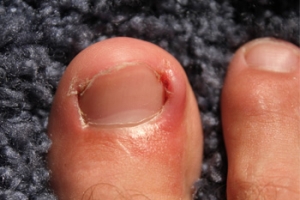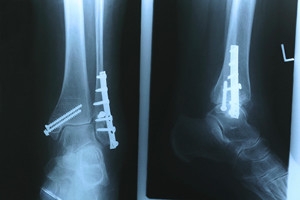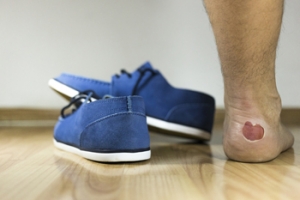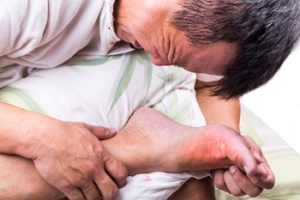
Foot Therapy for Sports Injuries
Whether in practice or in the game, athletes put their bodies through great stress. Some sports demand more from the body than others. However, every sport has an element of inorganic movement or unnatural motion. For example, in softball, a pitcher winds up and flings her body with an incredible amount of dexterity in order to get the most ideal velocity out of her pitches. This motion, incredibly taxing on the body, can cause serious injury.
One of the most common issues of athletic injuries happens in the feet. If it’s a damaging fracture that leaves the athlete sidelined or just a simple turf toe, foot injuries can still be very frustrating and painful. Regardless of the sport, athletes still require use of their feet in some fashion. This is why foot therapy is extremely vital for getting athletes back on the right track to return to the field.
No matter the injury, the best way to speed up the recovery period is to receive physical therapy. Physical therapy has proven to work for millions of people. Professional physical therapists are specifically trained to help people return to proper form from any injury.
During physical therapy, you will go through organized training in order to get back into form. Sometimes training can be quite difficult, especially in the beginning when there is more pain and the foot feels awkward. To alleviate this, you will do basic twisting and stretching exercises in order to get flexibility and foot mobility back up. The therapist will also massage the injured area to activate and relax muscles. Over time you will eventually move up to strengthening exercises, designed specifically so that the injured area is exercised.
Foot therapy for sports is a modern science miracle. Unlike other treatments that may employ the use of fancy chemicals and terminology, physical therapy is an evidence-based practice that offers the same benefits. Due to huge advancements in the knowledge of muscles and joints, doctors can turn catastrophic injuries around so that athletes can return to the game once more.
Do I Have An Ingrown Toenail?
 The toe that is most likely to develop an ingrown toenail is the big toe. An ingrown toenail is defined as the corner of the nail growing into the surrounding skin, which can cause severe pain and discomfort. It may happen as a result of wearing shoes that do not provide enough room for the toes to move freely in, or from trimming the toenails too short and incorrectly. Some people are born with irregular or curved toenails, and this may increase the probability of developing an ingrown toenail. Common symptoms that are often associated with this condition can include red and tender skin surrounding the affected nail, and fluid may drain from the area. If you are afflicted with an ingrown toenail, it is strongly advised that you are under the care of a podiatrist who can offer you correct treatment options.
The toe that is most likely to develop an ingrown toenail is the big toe. An ingrown toenail is defined as the corner of the nail growing into the surrounding skin, which can cause severe pain and discomfort. It may happen as a result of wearing shoes that do not provide enough room for the toes to move freely in, or from trimming the toenails too short and incorrectly. Some people are born with irregular or curved toenails, and this may increase the probability of developing an ingrown toenail. Common symptoms that are often associated with this condition can include red and tender skin surrounding the affected nail, and fluid may drain from the area. If you are afflicted with an ingrown toenail, it is strongly advised that you are under the care of a podiatrist who can offer you correct treatment options.
Ingrown toenails may initially present themselves as a minor discomfort, but they may progress into an infection in the skin without proper treatment. For more information about ingrown toenails, contact one of our podiatrists of Fusion Foot and Ankle. Our doctors can provide the care you need to keep you pain-free and on your feet.
Ingrown Toenails
Ingrown toenails are caused when the corner or side of a toenail grows into the soft flesh surrounding it. They often result in redness, swelling, pain, and in some cases, infection. This condition typically affects the big toe and may recur if it is not treated properly.
Causes
- Improper toenail trimming
- Genetics
- Improper shoe fitting
- Injury from pedicures or nail picking
- Abnormal gait
- Poor hygiene
You are more likely to develop an ingrown toenail if you are obese, have diabetes, arthritis, or have any fungal infection in your nails. Additionally, people who have foot or toe deformities are at a higher risk of developing an ingrown toenail.
Symptoms
Some symptoms of ingrown toenails are redness, swelling, and pain. In rare cases, there may be a yellowish drainage coming from the nail.
Treatment
Ignoring an ingrown toenail can have serious complications. Infections of the nail border can progress to a deeper soft-tissue infection, which can then turn into a bone infection. You should always speak with your podiatrist if you suspect you have an ingrown toenail, especially if you have diabetes or poor circulation.
If you have any questions, please feel free to contact our offices located in Fort Worth and Arlington, TX . We offer the newest diagnostic and treatment technologies for all your foot care needs.
Ingrown Toenails
Ingrown toenails (onychocryptosis) are a common foot ailment and it is very unpleasant to experience. The condition is caused by an increase in pressure from the ingrowth of the nail edge into the skin of the toe. Ingrown toenails commonly cause pain in those who experience them. In some cases, the skin surrounding the ingrown toenail may break which may lead bacteria to enter through and cause an infection. Common symptoms of this ailment include pain, redness, swelling, and warmth around the toe.
An imbalance between the size of the nail and the enlargement of the nail skin edge causes ingrown toenails. This condition is often caused by improperly trimming the toenails. If you are trying you cut your nails, you should always try to trim straight across instead of in a rounded shape. Ingrown toenails can also be an inherited condition and they may also be caused by improper shoe fitting.
Another common cause of the condition is wearing shoes that are either too small or too large. Other causes include poor foot hygiene, obesity, diabetes, arthritis, edema, and fungal infections. There are many risk factors that may make a person more likely to develop an ingrown toenail. Athletes who play “stop and start” sports such as tennis, soccer, and basketball are most likely to have ingrown toenails.
People who have diabetes, a compromised immune system, or poor circulation should immediately seek care from a podiatrist if they have an ingrown toenail. It is also recommended to seek professional assistance if at-home remedies are not successful within a week or if there is persistent pain.
Do I Have a Stress Fracture?
 A hairline fracture that gradually occurs may be defined as a stress fracture. It can happen as a result of frequently running or participating in sporting activities, and is known to develop from overuse. If a stress fracture is not promptly treated, it will typically get worse as the activity continues. The common symptoms that are associated with this condition may include swelling, pain and discomfort surrounding the affected area, and it may be difficult to walk. Factors that may lead to the development of a stress fracture can consist of wearing shoes that do not fit correctly, running on hard or uneven surfaces, or existing medical conditions such as osteoporosis. Relief may be obtained by elevating the affected foot, as this may help to reduce swelling. If you have endured a stress fracture it is suggested that you schedule a consultation with a podiatrist as quickly as possible, so proper treatment can begin.
A hairline fracture that gradually occurs may be defined as a stress fracture. It can happen as a result of frequently running or participating in sporting activities, and is known to develop from overuse. If a stress fracture is not promptly treated, it will typically get worse as the activity continues. The common symptoms that are associated with this condition may include swelling, pain and discomfort surrounding the affected area, and it may be difficult to walk. Factors that may lead to the development of a stress fracture can consist of wearing shoes that do not fit correctly, running on hard or uneven surfaces, or existing medical conditions such as osteoporosis. Relief may be obtained by elevating the affected foot, as this may help to reduce swelling. If you have endured a stress fracture it is suggested that you schedule a consultation with a podiatrist as quickly as possible, so proper treatment can begin.
Activities where too much pressure is put on the feet can cause stress fractures. To learn more, contact one of our podiatrists from Fusion Foot and Ankle. Our doctors can provide the care you need to keep your pain free and on your feet.
Dealing with Stress Fractures of the Foot and Ankle
Stress fractures occur in the foot and ankle when muscles in these areas weaken from too much or too little use. The feet and ankles then lose support when walking or running from the impact of the ground. Since there is no protection, the bones receive the full impact of each step. Stress on the feet can cause cracks to form in the bones, thus creating stress fractures.
What Are Stress Fractures?
Stress fractures occur frequently in individuals whose daily activities cause great impact on the feet and ankles. Stress factors are most common among:
- Runners
- People affected with Osteoporosis
- Tennis or basketball players
- Gymnasts
- High impact workouts
Symptoms
Pain from the fractures occur in the area of the fractures and can be constant or intermittent. It will often cause sharp or dull pain with swelling and tenderness. Engaging in any kind of activity which involves high impact will aggravate pain.
If you have any questions please feel free to contact our offices located in Fort Worth and Arlington, TX . We offer the newest diagnostic and treatment technologies for all your foot and ankle needs.
Dealing with Stress Fractures of the Foot and Ankle
Stress fractures are small breaks in the bone that are caused by repetitive stress. They typically occur due to overuse, forcing the bones of the foot or ankle to continually absorb the full impact of each step taken. Stress fractures can also be caused by abnormal foot structure, osteoporosis, bone deformities, or wearing improper footwear during exercise.
Stress fractures are common for individuals whose daily activities cause high levels of impact on their feet and ankles. Those who run, play tennis or basketball, or practice gymnastics tend to experience these fractures more frequently. Anyone is susceptible to this problem, though. Individuals who are normally sedentary and suddenly begin an intense, high impact workout may sustain stress fractures. This is because their muscles are not yet strong enough to handle and cushion the intensity of their activity. Osteoporosis may also cause someone to get stress fractures, because the disease weakens an afflicted person's bones and makes it easier for them to break down.
Pain from stress fractures typically occurs in the general area of the fracture. Pain can also manifest as “pinpoint pain” or pain that is felt when the site of the injury is touched, and can be accompanied by swelling. It may occur during or after activity, and it may disappear while resting and return when standing or moving. Engaging in any kind of activity, high impact or otherwise, will aggravate the pain. If the intensity of the activity increases before the stress fracture has properly healed, it can cause a full fracture.
Treatment can vary depending on the individual and the degree of injury. The primary way to treat a stress fracture is to rest the hurt foot. Some fractures will heal quickly with only a little bit of rest, while others may require a long rest period and the use of crutches, immobilization, or physical therapy. Under certain circumstances, surgery may be required to install support pins around the fracture to assist in healing.
If you are undergoing a new exercise regimen in running or some other kind of high impact activity, set incremental goals on a weekly basis so you can build up muscle strength. Make sure to wear supportive shoes to better protect you feet.
If you begin to experience any symptoms of stress fractures, you should stop exercising and rest. If the symptoms persist, consult with your podiatrist. Remembering these tips can help you prevent stress fractures to your foot and ankle, and allow you to continue living normally.
Are You Suffering From Ingrown Toenails?
Possible Causes for Blisters on the Feet
 A common cause for blisters to develop on the feet is excessive friction. This may come from wearing shoes that do not fit correctly, which may cause pain and discomfort. Consistent rubbing against the skin can cause the top layer of the skin to become damaged, creating a small pocket of fluid to form over it. This is the body’s natural method of healing the affected area. Additional reasons why blisters may form can occur as a result of standing for the majority of the day, or medical conditions that may include eczema and herpes. Some patients may have an allergic reaction to an insect bite which may also result in the development of a blister. It can help to cover the blister with an elastic bandage as daily activities are completed. The blister will gradually drain as new skin forms, and then the bandage can be removed. If you have a blister that is uncomfortable, please consult with a podiatrist who can help you find the remedy that is right for you.
A common cause for blisters to develop on the feet is excessive friction. This may come from wearing shoes that do not fit correctly, which may cause pain and discomfort. Consistent rubbing against the skin can cause the top layer of the skin to become damaged, creating a small pocket of fluid to form over it. This is the body’s natural method of healing the affected area. Additional reasons why blisters may form can occur as a result of standing for the majority of the day, or medical conditions that may include eczema and herpes. Some patients may have an allergic reaction to an insect bite which may also result in the development of a blister. It can help to cover the blister with an elastic bandage as daily activities are completed. The blister will gradually drain as new skin forms, and then the bandage can be removed. If you have a blister that is uncomfortable, please consult with a podiatrist who can help you find the remedy that is right for you.
Blisters are prone to making everyday activities extremely uncomfortable. If your feet are hurting, contact one of our podiatrists of Fusion Foot and Ankle. Our doctors can provide the care you need to keep you pain-free and on your feet.
Foot Blisters
Foot blisters develop as a result of constantly wearing tight or ill-fitting footwear. This happens due to the constant rubbing from the shoe, which can often lead to pain.
What Are Foot Blisters?
A foot blister is a small fluid-filled pocket that forms on the upper-most layer of the skin. Blisters are filled with clear fluid and can lead to blood drainage or pus if the area becomes infected.
How Do Blisters Form?
Blisters on the feet are often the result of constant friction of skin and material, usually by shoe rubbing. Walking in sandals, boots, or shoes that don’t fit properly for long periods of time can result in a blister. Having consistent foot moisture and humidity can easily lead to blister formation.
Prevention & Treatment
It is important to properly care for the affected area in order to prevent infection and ease the pain. Do not lance the blister and use a Band-Aid to provide pain relief. Also, be sure to keep your feet dry and wear proper fitting shoes. If you see blood or pus in a blister, seek assistance from a podiatrist.
If you have any questions, please feel free to contact our offices located in Fort Worth and Arlington, TX . We offer the newest diagnostic and treatment technologies for all your foot care needs.
Blisters on the Feet
Blisters are a common ailment of people who wear shoes that are either too tight or rub against the feet in an uncomfortable way. Knowing the basics of blisters is important for understanding how they are formed and what treatments should be used for them.
A blister on the foot, or any other part of the body, is a small pocket that is filled with fluid. It usually forms on the upper layer of the skin because these layers are loose enough to allow a blister to form. The most common fluid in a blister is just a clear, watery-like fluid that usually isn’t cause for concern. However, blisters can fill up with blood if they are deep enough and pus if they have become infected with bacteria.
Blisters almost always form on the feet due to shoes rubbing up against the foot, where the friction causes blisters. These can occur after you have walked for a long period of time or when your shoes do not fit you properly. Your feet are also more prone to blisters if they are moist, so keeping them dry and clean is one preventative step you can take.
Preventing infection should be the number one concern when treating blisters, as well as relieving the pain they can cause. Using a bandage to cover up the blister will help it heal and prevent bacteria from entering it. New skin will form under the blister and eventually cause it to pop. You can also take a sterilized pin and try to pop it yourself.
If the blister is filled with pus or blood, seeking treatment from a doctor is ideal. Antibiotics may need to be taken in order to completely eliminate the bacteria inside the blister. See a doctor to have an antibiotic prescribed.
The best way to treat blisters is to prevent them all together. Keeping your feet dry and making sure that your shoes fit properly are just two of the steps you can take to prevent blisters. Shoes that are too tight or shoes that are too loose and allow your feet to slide in them will cause blisters. Applying a bandage to an area where you think a blister is about to form is another way you can prevent them.
Types of Foot Pain Between the Toes and Heels
 There are several types of foot pain many people can experience in their lifetime. If you notice a bump gradually developing on the side of your big toe, you may have what is known as a bunion. This may come from wearing shoes that do not have adequate room for the toes to move freely in. A common foot condition that is known as cracked heels can occur from wearing shoes that have an open back, or from standing for the majority of the day. A small calloused area on the top of the toes may be a corn and can develop as a result of friction between the toes and the top of the shoe. Additionally, a blister can develop from excess friction, and will appear as a small bubble filled with protective fluid while the damaged area heals. If you have foot pain of any kind, please schedule a consultation with a podiatrist who can diagnose and treat your condition.
There are several types of foot pain many people can experience in their lifetime. If you notice a bump gradually developing on the side of your big toe, you may have what is known as a bunion. This may come from wearing shoes that do not have adequate room for the toes to move freely in. A common foot condition that is known as cracked heels can occur from wearing shoes that have an open back, or from standing for the majority of the day. A small calloused area on the top of the toes may be a corn and can develop as a result of friction between the toes and the top of the shoe. Additionally, a blister can develop from excess friction, and will appear as a small bubble filled with protective fluid while the damaged area heals. If you have foot pain of any kind, please schedule a consultation with a podiatrist who can diagnose and treat your condition.
Foot Pain
Foot pain can be extremely painful and debilitating. If you have a foot pain, consult with one of our podiatrists from Fusion Foot and Ankle. Our doctors will assess your condition and provide you with quality foot and ankle treatment.
Causes
Foot pain is a very broad condition that could be caused by one or more ailments. The most common include:
- Bunions
- Hammertoes
- Plantar Fasciitis
- Bone Spurs
- Corns
- Tarsal Tunnel Syndrome
- Ingrown Toenails
- Arthritis (such as Gout, Rheumatoid, and Osteoarthritis)
- Flat Feet
- Injury (from stress fractures, broken toe, foot, ankle, Achilles tendon ruptures, and sprains)
- And more
Diagnosis
To figure out the cause of foot pain, podiatrists utilize several different methods. This can range from simple visual inspections and sensation tests to X-rays and MRI scans. Prior medical history, family medical history, and any recent physical traumatic events will all be taken into consideration for a proper diagnosis.
Treatment
Treatment depends upon the cause of the foot pain. Whether it is resting, staying off the foot, or having surgery; podiatrists have a number of treatment options available for foot pain.
If you have any questions, please feel free to contact our offices located in Fort Worth and Arlington, TX . We offer the newest diagnostic and treatment technologies for all your foot care needs.
Foot Pain
Our feet are arguably the most important parts of our bodies because they are responsible for getting us from place to place. However, we often don’t think about our feet until they begin to hurt. If you have pain in your feet, you need to first determine where on the foot you are experiencing it to get to the root of the problem. The most common areas to feel pain on the foot are the heel and the ankle.
Heel pain is most commonly attributed to a condition called plantar fasciitis. Plantar fasciitis occurs when the plantar fascia, which is the band of tough tissue connecting the heel bone to the toes becomes inflamed. Plantar fasciitis pain is usually worse in the morning, and it tends to go away throughout the day. If you have plantar fasciitis, you should rest your foot and do heel and foot muscles stretches. Wearing shoes with proper arch support and a cushioned sole has also been proven to be beneficial.
Some common symptoms of foot pain are redness, swelling, and stiffness. Foot pain can be dull or sharp depending on its underlying cause. Toe pain can also occur, and it is usually caused by gout, bunions, hammertoes, ingrown toenails, sprains, fractures, and corns.
If you have severe pain in your feet, you should immediately seek assistance from your podiatrist for treatment. Depending on the cause of your pain, your podiatrist may give you a variety of treatment options.








